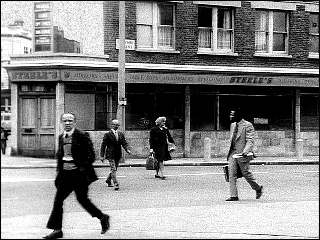In the poem about love you don't write the word love
Published June 27th, 2007 by Kristoffer Knutson
In the poem about love you don't write the word love
at Midway Contemporary Art
527 2nd Ave. SE, Mpls, MN 55414
through July 28th.
As I drive to Midway Contemporary Art from the busy intersection of Hennepin and Central, my little black car takes three right turns – spiraling like a leaf into an eddy. Tucked into the seam between Southeast and Northeast, this cul de sac is a likely place for the academic flights of the University's main campus to swirl with the new art energy that builds to the North of East Hennepin Avenue: a place for those edicts and postulates - shed on scraps of paper from the University's highest parapets – to drift into some contact with the rest of us.
Curated by Tanya Leighton, “In the poem about love you don't write the word love” is a quietly devastating exhibition. With a span of forty years and a range of the entire globe, Leighton has carefully constructed a room full of visual booby traps. Students of culture and literature are fond of juicy words: we find identification with a film through suture, a break in our comfortable way of looking at things is a rupture. These are violent words, and Leighton chooses works that make them hurt.
As hinted by the title, no individual work puts a fine point on the central questions of the exhibition. But across the many film installations and a smattering of more corporeal work, a set of ideas and concerns does emerge. After my third visit, the exhibition is best viewed as a fractured experience to be united by the viewer – a tea leaf reading, an imaginative pondering of clouds, a synthesis of the morning's headlines and the day's dreaming. Its main parts are the extensive video exhibitions with which I would include the still photography of David Lamelas, the sculptural work, which I will only briefly touch on here, and a glut of written words.
 If there is a single work that suggests the scope of the entire show, it is the most recent: François Bucher's “Forever Live: The Case of K. Gun” (2006). In this mixed installation, a video shows a man on the telephone in an office overlooking the U.N. building. The soundtrack, what he ostensibly hears, is not a wiretap of U.N. sessions, but Gun herself translating Kafka's “Before the Law” from Chinese to English. Alongside the little television that shows the video, newspaper front pages recall the media celebrity “Katherine Gun,” a momentary tabloid star, a glamorous, leggy and unrepentant traitor for peace. “Forever Live” celebrates the creation of this hero while suggesting what further secrets might be concealed.
If there is a single work that suggests the scope of the entire show, it is the most recent: François Bucher's “Forever Live: The Case of K. Gun” (2006). In this mixed installation, a video shows a man on the telephone in an office overlooking the U.N. building. The soundtrack, what he ostensibly hears, is not a wiretap of U.N. sessions, but Gun herself translating Kafka's “Before the Law” from Chinese to English. Alongside the little television that shows the video, newspaper front pages recall the media celebrity “Katherine Gun,” a momentary tabloid star, a glamorous, leggy and unrepentant traitor for peace. “Forever Live” celebrates the creation of this hero while suggesting what further secrets might be concealed.
Walid Raad's beautiful “I Only Wish that I Could Weep” (2001), comprises seven minutes of blurry Lebanese sunsets as taken from a busy espalande The tapes, we are told, are from a security camera operator who went rogue and trained his camera away from the subject and onto the sunset each night. This back story's fantasy, however, belongs to Michel de Certeau's Everyday Life, and is as much his invention as an invention of the artist.
 To provide some historical context for this video work, John Smith's cheeky “Girl Chewing Gum” (1976) subverts the authorized interpretation of imagery by absurdly exaggerating the potency of word when applied to image. In a twelve-minute take of an ordinary busy street, a voiceover seems to direct the random events that unfold there. It quickly becomes evident that the scene is not responding to the voice, but vice-versa. Through staggering image and sound track, the voice seems to gain powerful authority over the scene, predicting events that the images this confirm. How much is this simple trick like viewing the evening news? Much like Chris Marker's best work, Smith's film exposes the constructedness of the real in a way that is fundamentally destabilizing.
To provide some historical context for this video work, John Smith's cheeky “Girl Chewing Gum” (1976) subverts the authorized interpretation of imagery by absurdly exaggerating the potency of word when applied to image. In a twelve-minute take of an ordinary busy street, a voiceover seems to direct the random events that unfold there. It quickly becomes evident that the scene is not responding to the voice, but vice-versa. Through staggering image and sound track, the voice seems to gain powerful authority over the scene, predicting events that the images this confirm. How much is this simple trick like viewing the evening news? Much like Chris Marker's best work, Smith's film exposes the constructedness of the real in a way that is fundamentally destabilizing.
Plenty of other essential films are on display here, including Jean-Luc Godard and Anne-Marie Melville's “Ici et ailleurs (Here and Elsewhere)” (1970/1976), a piece that recycles footage from a failed Vertov Group documentary on the P.L.O. in order to pose questions sharpened by the events at the Munich games between the two films' shooting dates. This film is so stunning and reaching in its ramifications that any further treatment here would be inadequate.
The written portion of this exhibition strengthens the works' mysterious relevance to our present moment. A 250 page trade paperback contains essays specific to the exhibition or specific to the work alongside those that have no obvious connection. Among a roster of popular cultural studies texts, a pair of Haruki Murakami characters sleepwalk through the Sarin gas attack on the Tokyo subway. Elsewhere, Jonathan Crary shifts our focus from the historical revolutions in practices of representation to settle our focus on the development of the post modern observer, suggesting that a post-renaissance multiplication of both realist and abstract representations has had an inverted effect on the modern subject.
If all of this seems a little heady, the exhibit itself is not. One can take it at face value, a dystopian swirl of newsprint, newsreel, white on white objects, framed texts and codes inscribed on frames. Unconsciously, the exhibition unfolds as a dream. But to listen for its meaning and how that meaning is produced accepts Leighton's invitation to hold the viewer in a state of anticipation which, she argues, is the only way that the visual can engender free thought – to rupture our passive way of seeing. Leighton says this “locates the viewer between memory and anticipation.”
Thus emplaced, a viewer may find himself retreating a bit dizzied from the looping film and the constant assault on his comfortable viewing position. He may turn his car back into the stream of constant and purposeful traffic along Central Avenue, bringing with him the brown bagged lunch of Leighton's companion volume, to be unfolded for echoes and provocations.
Collier White
06/27/07
We can't do it without you.
Help keep independent arts journalism alive in the Twin Cities.